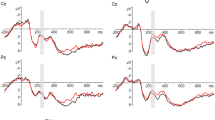Abstract
Rhyme priming to visually dissimilar rhymes (e. g., eight-late) was used in a lexical decision task to investigate the access and maintenance of speech-based codes in sentence comprehension. One member of the rhyme pair was embedded in a sentence and the other was presented visually for lexical decision. Rhyme priming obtained when the prime and target were separated by four but not by seven intervening words, suggesting that the phonological code for the word was initially accessed and then rapidly decayed.
Similar content being viewed by others
References
Bever, T. G., & Hurtig, R. R. (1975). Detection of a nonlinguistic stimulus is poorest at the end of a clause.Journal of Psycholinguistic Research, 4, 1–7.
Caplan, D. (1972). Clause boundaries and recognition latencies for words in sentences.Perception and Psychophysics, 12, 73–76.
Chang, F. R. (1980). Active memory processes in visual sentence comprehension: Clause effects and pronominal reference.Memory and Cognition, 8, 58–64.
Frazier, L., & Fodor, J. D. (1978). The sausage machine: A new two-sage parsing model.Cognition, 6, 291–326.
Hillinger, M. I. (1980). Priming effects with phonemically similar words: The encoding-bias hypothesis reconsidered,Memory and Cognition, 8, 115–124.
Koriat, A. (1981). Semantic facilitation in lexical decisions as a function of prime-target association.Memory and Cognition, 9, 587–598.
Levy, B. A. (1977). Reading: Speech and meaning processes.Journal of Verbal Learning and Verbal Behavior, 16, 623–638.
Levy, B. A. (1978). Speech processing during reading. In A. M. Lesgold, J. W. Pellegrino, J. W. Fokkemea, & R. Glaser (Eds.),Cognitive psychology and instruction. New York: Plenum.
McCusker, L. X., Hillinger, M. I., & Bias, R. G. (1981). Phonological Recoding and Reading.Psychological Bulletin, 89, 217–245.
Meyer, D. E., Schvaneveldt, R. W., & Ruddy, M. G. (1975). Loci of contextual effects on visual word recognition. In P. M. A. Rabbit and S. Dornic, (Eds.),Attention and Performance V: London: Academic Press.
Onifer, W., & Swinney, D. A. (1981). Accessing lexical ambiguities during sentence comprehension: Effects of frequency of meaning and contextual bias.Memory and Cognition, 9, 225–236.
Seidenberg, M. S., Tanenhaus, M. K., Leiman, J. M., & Bienkowski, M. A. (1982). Automatic access of the meanings of ambiguous words in context: Some limitations of knowledge-based processing.Cognitive Psychology, 14, 489–537.
Seidenberg, M. S., Waters, G. S., Sanders, M., & Langer, P. (1984). Pre- and Post-Lexical loci of priming.Memory and Cognition, 12, 315–328.
Slowiaczek, M. L., & Clifton, C. (1980). Subvocalization and reading for meaning.Journal of Verbal Learning and Verbal Behavior, 19, 573–582.
Swinney, D. A. (1979). Lexical access during sentence comprehension. (Re) consideration of context effects.Journal of Verbal Learning and Verbal Behavior, 18, 645–660.
Tanenhaus, M. K., Flanigan, H., & Seidenberg, M. S. (1980). Orthographic and phonological code activation in auditory and visual word recognition.Memory and Cognition, 8, 513–520.
Tanenhaus, M. K., Leiman, J. M., & Seidenberg, M. S. (1979). Evidence for multiple stages in the processing of ambiguous words in syntactic context.Journal of Verbal Learning and Verbal Behavior, 18, 427–441.
Wanner, E., & Maratsos, M. (1978). An ATN approach to comprehension. In M. Halle, J. Bresnan, and G. A. Miller (Eds.),Linguistic Theory and Psychological Reality. Cambridge, Massachusetts: M. I. T. Press.
Waters, G. S., Komoda, M. K., & Arbuckle, T. Y. (1985). The effects of concurrent tasks on reading: Implications for phonological recoding.Journal of Memory and Language, 24, 27–45.
Author information
Authors and Affiliations
Rights and permissions
About this article
Cite this article
Hudson, S.B., Tanenhaus, M.K. Phonological code activation during listening. J Psycholinguist Res 14, 557–567 (1985). https://doi.org/10.1007/BF01067385
Accepted:
Issue Date:
DOI: https://doi.org/10.1007/BF01067385




